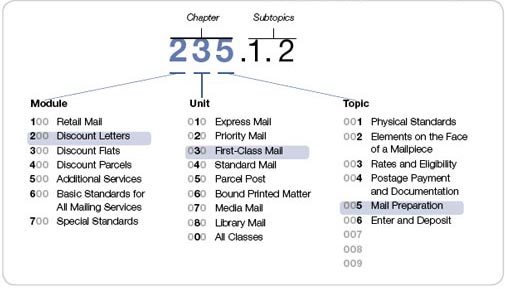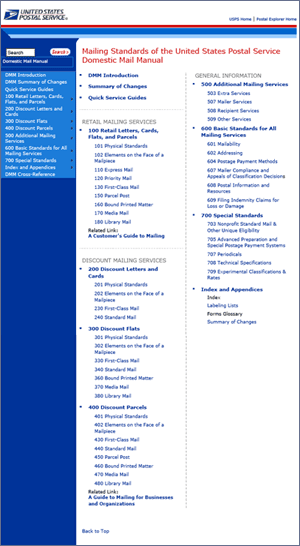| Mailing Standards of the
United States Postal Service
Domestic Mail Manual Introduction
Transforming the Domestic Mail
Manual


The Postal Service has transformed
the Domestic Mail Manual (DMM) into a series of documents that are
easier for customers and employees to use.
Publications in the DMM Series
A Customer’s Guide to Mailing answers
the most common questions of household mailers. It includes
tips for addressing,
preparing packages, choosing a class of mailing, and adding extra services.
It is available at www.usps.com/customersguide and
most post offices in English, Spanish, and Chinese.
A Guide to Mailing for Businesses and Organizations provides an overview
of mailing options for businesses and organizations. Mailers can use it to
begin
a business mailing program and make better-informed decisions about mailing.
This document is available at pe.usps.com,
larger post offices, business mail entry units.
Mailing Standards of the United States Postal Service contains all official rates
and standards governing domestic mailing services and is mostly used by discount
mailers and Postal Service employees. This document is available at pe.usps.com.
Mailing Standards of the United States
Postal Service
makes it easier to access information about postal
services and standards.
The new DMM provides the following benefi ts
and features:
- Increased ability to fi nd information.
- Increased clarity of mailing standards.
- Expanded and improved index.
- Clearer graphics and rate charts.
- Less need to consult with experts or peers for guidance.
- Increased customer confi dence in the mail and
in the USPS.
- Information grouped by mailing method, shape,
class of mail, and topic.
- Less time spent cross-referencing and greater
confi dence in fi nding all the information needed.
The Postal Service worked closely with customers
and employees to reorganize the DMM. The new
DMM will help customers make informed decisions
about postal products and services to get the most
value from the mail. Postal employees will fi nd it
easier to help customers.
The mailing standards did not change as part of
the redesign process. What is new is how the
standards are organized and presented.
Organization
Mailing Standards of the United States Postal Service is
organized into color-coded modules that make it easy to locate information
quickly.
The RETAIL section explains the services and standards for letters,
flats, and parcels mailed at single-piece rates. The information in
this section is intended for both household consumers and businesses.
The
DISCOUNT sections explain the services and standards for “bulk,” presorted,
and automation rate mail. The information in this section is intended
for business mailers who are willing to do
some extra work preparing their mail in exchange for discounted postage
rates.
Standards in the retail section are organized into units represented
by the available mailing services. Within each mailing service, the information
is organized into chapters that follow the sequence of mailing tasks.
The GENERAL INFORMATION sections contain standards for all the
additional services available to mailers, including extra services,
mailer services, and recipient services. The general information sections
also
include standards that apply to all mailers, such as general mailability
and addressing, and special standards, such as technical specifications
and advanced preparation standards.

Overview
The modules for each method and shape of mail contain general
design standards and topics relating to the preparation of each class
of mail.
101 Physical Standards
102 Elements on the
of a Mailpiece
113 Rates and Eligibility
114 Postage Payment
115 Mail Preparation
116 Deposit
123 Rates and Eligibility
124
Postage Payment
125 Mail Preparation
126 Deposit
133 Rates and Eligibility
134
Postage Payment
135 Mail Preparation
136 Deposit
153 Rates and Eligibility
154 Postage Payment Methods
155
Mail Preparation
156 Deposit
163 Rates and
Eligibility
164 Postage Payment Methods
165 Mail Preparation
166 Deposit
173
Rates and Eligibility
174 Postage Payment Methods
175 Mail Preparation
176
Deposit
183 Rates and Eligibility
184 Postage Payment
Methods
185 Mail Preparation
186 Deposit
201 Physical Standards
202 Elements on the Face
of a Mailpiece
233 Rates and Eligibility
234 Postage
Payment and Documentation
235 Mail Preparation
236 Enter and Deposit
243 Rates and Eligibility
244 Postage Payment and Documentation
245
Mail Preparation
246 Enter and Deposit
301 Physical Standards
302 Elements on the Face
of a Mailpiece
333 Rates and Eligibility
334 Postage
Payment and Documentation
335 Mail Preparation
336 Enter and Deposit
343 Rates and Eligibility
344 Postage Payment and Documentation
345
Mail Preparation
346 Enter and Deposit
363 Rates and Eligibility
364 Postage Payment
and Documentation
365 Mail Preparation
366 Enter and Deposit
373 Rates and Eligibility
374 Postage Payment and Documentation
375
Mail Preparation
376 Enter and Deposit
383 Rates and
Eligibility
384 Postage Payment and Documentation
385 Mail Preparation
386
Enter and Deposit
401 Physical Standards
402 Elements on the Face
of a Mailpiece
433 Rates and Eligibility
434 Postage
Payment and Documentation
435 Mail Preparation
436 Enter and Deposit
443 Rates and Eligibility
444 Postage Payment and Documentation
445
Mail Preparation
446 Enter and Deposit
453 Rates and
Eligibility
454 Postage Payment and Documentation
455 Mail Preparation
456
Enter and Deposit
463 Rates and Eligibility
464
Postage Payment and Documentation
465 Mail Preparation
466 Enter and
Deposit
473 Rates and Eligibility
474 Postage Payment
and Documentation
475 Mail Preparation
476 Enter and Deposit
483 Rates and Eligibility
484 Postage Payment and Documentation
485
Mail Preparation
486 Enter and Deposit
Services and standards that apply generally to all customers
are organized into three tabbed sections.
Extra Services for Express
Registered Mail
Certified Mail
Insured Mail
Certificate of Mailing
Return
Receipt
Restricted Delivery
Return Receipt for Merchandise
Delivery Confirmation
Signature
Confirmation
Collect on Delivery (COD)
Special Handling
Confirm
Money Orders
Treatment of Mail
Forwarding
Address Correction Services
Recall
of Mail
Pickup Service
Mailing List Services
Address Sequencing Services
Business
Reply Mail (BRM)
Merchandise Return Service
Bulk Parcel Return Service
Recipient Options
Conditions of Delivery
Customer Mail
Receptacles
Post Office Box Service
Caller Service
General Delivery
Firm
Holdout
Pandering Advertisements
Sexually Oriented Advertisements
Address Information System
Nonpostal Services
Numbering System
The numbering system can serve as a navigational tool for locating
standards quickly.

Page Layout
The new layout includes new graphic features and navigation elements
that help you find the information you need.

A. Chapter Title
The DMM is divided
into chapters based
on mailing topics.
B. Overview
Each chapter begins
with a table of
contents.
C. Reference Number
Each section, subsection, and standard has its own reference number. D. Change Bar
Change bars next to
standards indicate
that the text has
changed since the
last printed edition.
E. Change Date
The change date
indicates the date a
change is effective.
F. DMM 58 Reference
Reference numbers
corresponding to
the old DMM system
(DMM 58) are provided
to help the transition
to the new numbering
system.

G. Chapter Header
The header lists the
module, unit, and
chapter.
H. Chapter Number
This number shows
the current chapter for
easy navigation.
I. Page-level
Navigation
This element shows
the number of the first
or last reference on
each page.
J. Shape Icon
Icons provide a visual
point of reference.
K. Exhibit
Illustrations and
diagrams provide clear
visual explanations
and examples.
L. Cross-reference
Cross-references point
to other required or
related standards.
They are hyperlinked
in the online DMM for
quick access.
M. Rate Table
New table designs
aid in locating and
reading rates easily.
N. DMM Issue and Date
The DMM is updated
monthly.
Postal Explorer
pe.usps.com
Postal Explorer is an easy-to-use website that provides a comprehensive
collection of business mailing tools, including Mailing Standards of
the
United States Postal Service.

With Postal Explorer you can:
- Get the most up-to-date information.
- Access the Quick Service Guides.
- Enter a word or phrase and instantly fi nd all references.
- Access postage statements and forms.
- Search one publication or a whole collection.
- Calculate domestic and international retail and discount
postage rates.
- Print all or part of the DMM.
- Access postal zone charts.
You will find the most up-to-date
version of Mailing Standards of
the United States Postal Service: Domestic Mail Manual (DMM)
in HTML and PDF formats.
The online DMM features new
interactive menus and enhanced
search options.

Domestic Mail Manual Introduction
PSN: 7610-07-000-5420
January 2005
Back to Top

|

 DMM 100
DMM 100 DMM 200
DMM 200 DMM 300
DMM 300 RETAIL MAILING SERVICES
RETAIL MAILING SERVICES DISCOUNT MAILING SERVICES
DISCOUNT MAILING SERVICES




